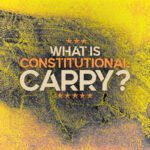
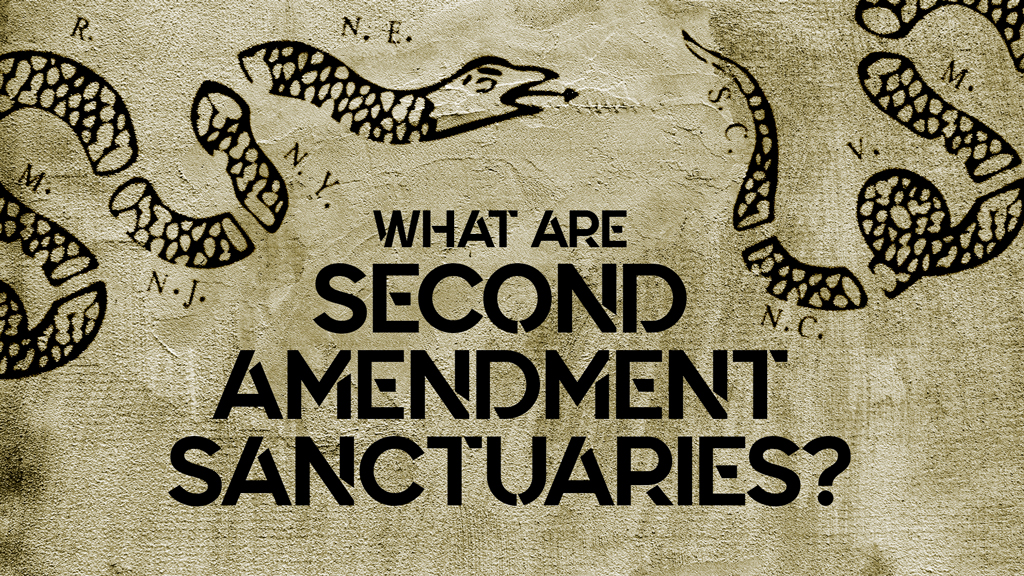
By Guy J. Sagi
The Second Amendment sanctuary movement has served notice to legislators and gained the kind of momentum that demands mainstream media attention. Enrollment is expanding across the nation and the signal it’s sending is clear. Law-abiding citizens are no longer willing to silently surrender their constitutionally guaranteed right to keep and bear arms—even if officials serving in their state legislature are.
There are no signs of slowing, either. A January report by The Hill indicated at least 131 counties nationwide declared themselves Second Amendment sanctuaries in December alone. January’s total was up to 83 when the story appeared. Gun bloggers and pro-2A supporters began sharing the story links, organizing for the cause online and on social media. A comprehensive Wikipedia list of enrollees is staggering.
It’s textbook democracy at its finest. Grassroots constituents work with elected county and city officials to introduce resolutions that declare their region a Second Amendment sanctuary. Legal experts claim the effort is mostly symbolic, but the energy created and reaction by opponents has been tectonic.
What Is A Second Amendment Sanctuary?
A Second Amendment sanctuary is a county, city or state that has adopted a resolution or enacted a law that impedes its officials and staff from assisting in the enforcement of laws that violate the Second Amendment rights of law-abiding citizens. The language is strong and the message clear. Is it effective? Because of state and local regulation hierarchy, the net effect isn’t as dangerously defiant as it sounds.
| Second Amendment Sanctuaries | Quick Answer Box |
|---|---|
| What is it? | States, counties, or localities in the USA that pass laws or resolutions against gun control measures. |
| What does it do? | Legislative protection against infringements of citizen’s Second Amendment rights. |
| Is it effective? | Unknown. It has yet to be challenged in a court of law. |
| Who implemented it first? | Carroll County, Maryland on May 21st, 2013. |
| Which movement came first? | The sanctuary city movement came before the Second Amendment sanctuary movement. |
NBC-affiliate 10 News asked Rich Schragger, a professor who specializes in constitutional law at the University of Virginia, about the legal ramifications. “There is some room for local police departments and local officers to use their discretion with the laws, and that was the same thing with sanctuary cities in terms of immigration policy,” he said. “Mostly, declaring yourself a Second Amendment sanctuary is more of a symbolic statement.
North Carolina’s High Point University Political Science Professor Dr. Brandon Lenoir agreed in his interview with CBS News affiliate WFMY. “Really it’s more symbolic than anything,” he said. “It’s not enforceable and if the federal government and the state government actually wanted to enforce the laws they would be able to do that in these quote-unquote sanctuary counties.”
Regardless, it’s a strong message. It’s also struck a nerve in some politicians ready to surrender the Second Amendment for political gain.
Virginia Study
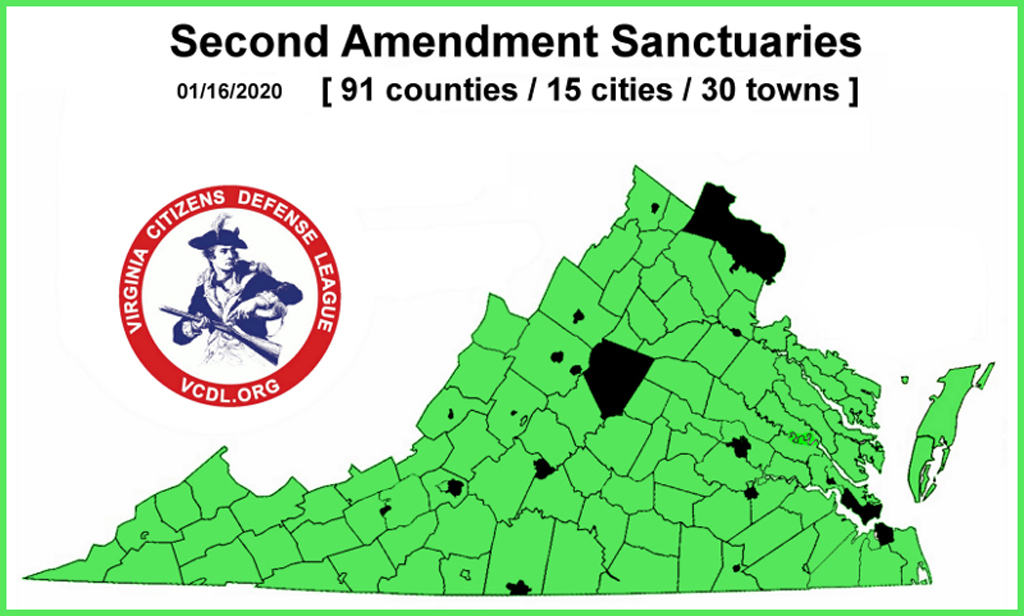
As of January 2020, there are over 91 counties in Virginia that have declared themselves to be Second Amendment sanctuaries. (Credit: VCDL.org)
Virginia is a glaring example. Everytown for Gun Safety invested $2.5 million toward the campaign funds of candidates there last year. After results were in, CNBC summarized, “A gun-control lobbying group funded largely by billionaire Michael Bloomberg just helped Democrats take over the state government in Virginia—right in the National Rifle Association’s backyard.”
It wasn’t long before the new legislators were pre-filing measures that included outright firearm bans, magazine size limits, registration and more. Gun owners responded by starting Second Amendment sanctuaries.
As of Jan. 16, according to 10 News, 105 cities and counties in Virginia were enrolled. Campbell County was the state’s first, on Nov. 7. Another 104 followed, which works out to more than one legislative body declaring its support for the Second Amendment every day.
Tyranny Embodied?
The trend didn’t sit well with Gov. Ralph Northam, who was eager to exploit the fresh crop of legislators who also embrace gun-control legislation. “If we have constitutional laws on the books and law enforcement officers are not enforcing those laws on the books then there are going to be some consequences but I’ll cross that bridge if and when we get to it,” Northam said at a Virginia Beach speech on Dec. 11, according to ABC TV News affiliate WSET.
U.S. Representative Donald McEachin (D-VA) took it a step further, according to the Washington Examiner.. “And ultimately, I am not the governor, but the governor may have to nationalize the National Guard to enforce the law,” he’s quoted as saying. “That’s his call, because I don’t know how serious these counties are and how severe the violations of law will be. But that’s obviously an option he has.”
Meanwhile, Culpeper County (VA) Sheriff Jenkins told Fox & Friends he’s willing to deputize constituents to protect their Second Amendment rights. “They will be properly vetted through a normal process,” he explained on the nationally televised program. “Everything from normal background checks that we do for other deputy sheriffs as well as psych [evaluations]. It’s not just a blanket policy of swearing-in anyone who is interested.”
Lobby Day: Peaceful & Respectful
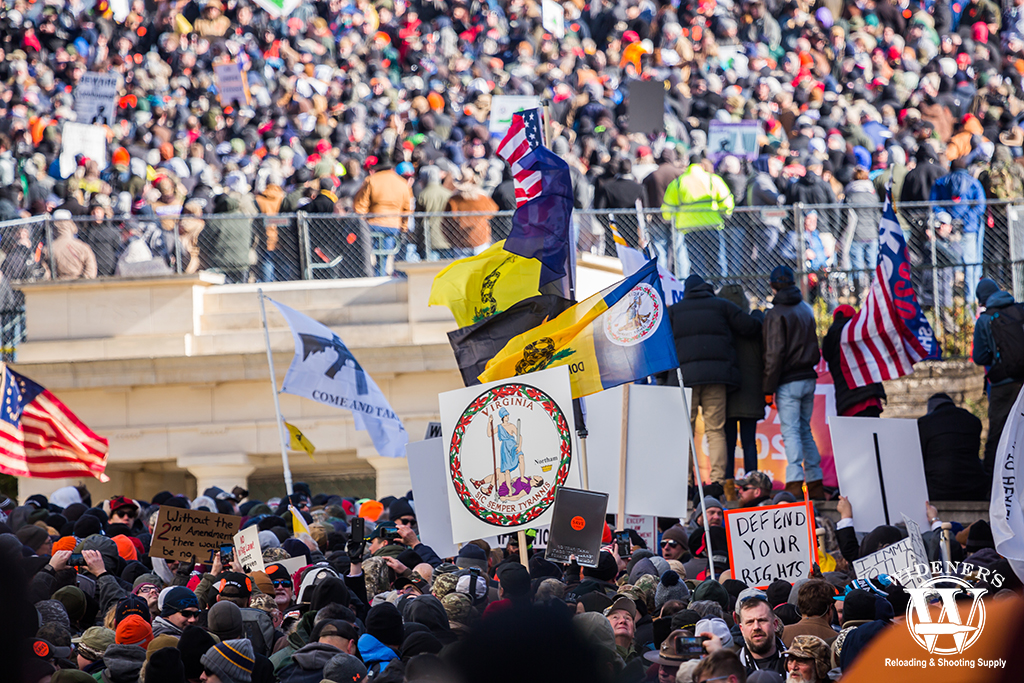
Pro-Second Amendment supporters peacefully packed out the front lawn at the annual Lobby Day in Virginia. (Credit Brian Brown)
The verbal and political sparring came to a head on Jan 20, 2020 when the Virginia Citizens Defense League held its annual Lobby Day Rally in Richmond, VA. Attendance was record-setting. The Second Amendment sanctuary movement fueled heavy media coverage and Gov. Northam’s declaration of a state of emergency, which made it illegal to carry a firearm on state grounds.
The Virginia Division of Capitol Police estimated the crowd numbered somewhere around 22,000. Six thousand passed through metal detectors unarmed to enter the state capitol grounds. There were no incidents. The rest—some 16,000—staged a separate protest outside the fences, with most openly carrying a firearm.
Despite the number of guns in attendance, there were no negligent discharges or unlawful brandishing. CNN reports police did arrest a 21-year-old girl after she ignored multiple requests that she remove a bandana from her face.
Sanctuary History
The movement modestly began in 2010, when Wyoming and Alaska declared firearm freedom acts. Kansas enacted a Second Amendment Protection Act in 2013 and the Idaho Federal Firearm, Magazine and Register Ban Enforcement Act followed in 2014.
All garnered media attention, but nothing like what followed four years later. In 2018 the Illinois legislature was eyeing five pieces of legislation that would further erode the Second Amendment rights of residents.
It started when Effingham County (IL) Board Member David Campbell approached Bryan Kibler, the County State’s Attorney. Iroquois County, also in Illinois, had passed a pro-gun resolution, but the legislator wanted something with more impact. The pair decided to borrow an immigration-movement term. The Chicago Tribune reports Kibler’s side of the exchange as, “I said, well, they’re creating sanctuary counties for illegals up in Chicago, why don’t we just steal their word and make Effingham County a sanctuary county for firearms?”
They get credit for being the first Second Amendment sanctuary in the nation, although there’s no official record keeper. Today the movement is catching on in a variety of other states. Many not yet even facing political forces intent on surrendering gun rights.
America’s Second Amendment Sanctuaries
The list includes Alcorn, DeSoto and Lawrence counties in Mississippi, a state well known for not compromising the right to keep and bear arms. Illinois has 67 of its 102 counties enrolled, sending a clear signal to traditionally anti-gun legislators in Springfield. The desert oasis city of Needles is, unfortunately, liberal California’s first and only member.
There are 27 states in all with localities that have declared themselves Second Amendment sanctuaries. They include Arizona, California, Colorado, Florida, Georgia, Illinois, Indiana, Kentucky, Maine, Maryland, Michigan, Mississippi, Nevada, New Jersey, New Mexico, New York, North Carolina, Ohio, Oregon, Pennsylvania, Rhode Island, Tennessee, Texas, Vermont, Virginia, West Virginia and Wisconsin.
In addition, a number of local law enforcement officials in Washington state have vowed not to enforce portions of a 2018 gun-control measure passed there until it survives a pending court challenge.
Support Of Your Local Sheriff
Virginia’s overwhelming enrollment of sanctuaries, positive media coverage and overreaction by gun-control enthusiasts makes it obvious the message is effective. Law-abiding gun owners are not willing to surrender their right to keep and bear arms. But there’s another facet to the Second Amendment sanctuaries story that hinges on a little-known fact about county Sheriffs.
The National Liberty Alliance explains it best [PDF] on its website. “The County Sheriff is a Constitutional Officer; elected by the People; and, bound by oath as guardian of the Peoples’ unalienable rights secured by the Constitution. The Constitution for the United States of America and its capstone Bill of Rights is the ‘Law of the Land,’ and, all statutes and state constitutions repugnant to the Constitution for the United States of America are null and void.”
The organization also details that, “The Duties, Responsibilities and Authorities of the Sheriff Cannot be Diminished by those in the legislature and courts; nor can it be diminished by any state constitution. When it comes to enforcing the Law, which is to say enforcing the Constitution for the United States of America, the Sheriff, being the ‘Chief Law Enforcement Officer,’ answers to We the People; no one else, not even the Governor…”
Coming To A Neighborhood Near You
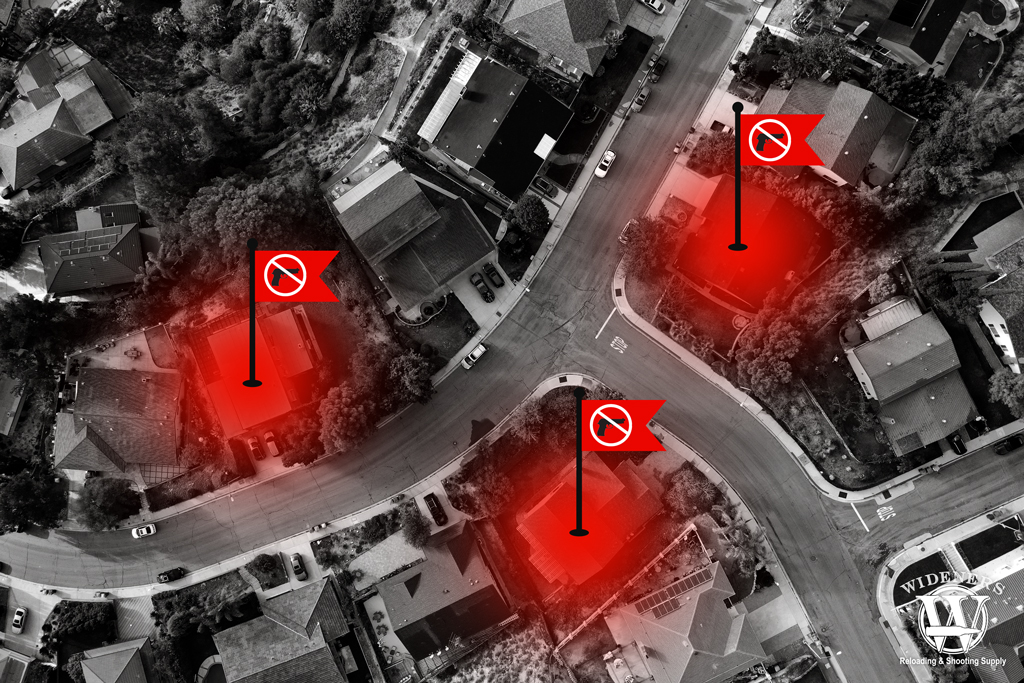
Red flag laws may sound well-meaning but are ultimately unconstitutional violations of the 4th amendment.
There are reasons areas relatively immune to Second Amendment infringement are becoming sanctuaries. Second Amendment sanctuaries are primarily a peaceful declaration of support for gun rights and a strong show of political might.
There’s also the chance a legislator serving in a distant state capital will introduce a measure out of political convenience. So-called red flag laws sound well-meaning enough to pass muster with some representatives, for example, but they carry far-reaching consequences. An estranged spouse, for example, angry neighbor or anti-gun co-worker can call law enforcement and claim you’re a threat.
Once they expose that the person in question owns firearms, mandatory confiscation of them (and ammo) follows—without so much as a hearing or any due process. The feel-good and misguided measures are fertile ground for anyone holding a grudge. If you thought the tragedies occurring around the phenomenon of “swatting” were bad, wait until you see lives that are ruined by vengeful “red-flagging.” Often, these unlawful property seizures don’t include language to address the recovery of seized property, allowing for further government overreach and corruption. One of these measures is currently being debated by lawmakers in New Mexico.
It’s A Numbers Game
Washington state is considering making it illegal to own magazines with a capacity greater than 10 rounds. So is Hawaii. The anti-gun legislation is too long to list, but invasions on other fronts are also routine. New Hampshire, for example, could repeal its shooting range protection law. The move would open facilities to frivolous noise-related lawsuits by homeowners and other litigation, resulting in increased cost and, likely, shutdowns due to financial exposure. It’s hard to enlist the next generation of enthusiasts when the nearest place to shoot is hours, perhaps days, away.
New Assault Weapons Ban?
The so-called assault weapons ban began in 1994 and expired in 2004. Since then, statistics have clearly shown there’s been no increase in criminal use. The feel-good measure had no effect at all. Despite that fact, state legislatures resurrect the issue annually for consideration. In fact, Fox News reports Virginia Gov. Northam’s Democratic majority is working toward registration or confiscation of all AR-15s in the state. They’re doing it with or without grandfather clause, depending on bill author and star alignment as it’s being written.
Universal Background Check Fallacy
Universal background checks are another of those subjects liberal legislators and well-meaning voters support. The thought of going through the expense and effort to gift a family heirloom to a child or grandchild is repulsive to most firearm owners. Inconvenience is one factor, but here’s a more sinister problem at hand.
The National Review explained the unforeseen Catch 22 well in August 2019. “Equally problematic is that universal background checks require the creation of a national gun registry that can be used to check compliance,” the editors wrote. “Indeed, without such a registry, the system is rendered useless because there is no way for the government to prove whether a transaction has been made in compliance with the law or outside of it.”
Even if proponents tiptoe around that political minefield, there’s an identity-theft concern underscored late last year. “Law-abiding gun owners who complied with New Zealand’s mandatory gun buyback program and surrendered their assault weapons to the government discovered Monday that their privacy had been compromised by poor website security,” according to Reason Magazine. Is that kind of exposure wise just to pass on a grandfather’s old, bolt-action Enfield? Social Security numbers and dates of birth are one thing, but the addresses also provide criminals with a convenient shopping list.
Justified Defiance

Citizens in Virginia rallied using their First Amendment rights to protect their Second Amendment freedoms. (Credit Brian Brown)
At the very least the Second Amendment sanctuary movement makes a strong political statement. The experts dismiss it as little more than symbolic, but the 2018 fates of three California immigration sanctuary “laws” hint at something different. The Golden State measures made it so difficult to deport criminals without citizenship that the U.S. Justice Department took the Governor and State Attorney General to court. A federal judge ultimately struck down a key provision in one of the laws, but the other two stood untouched.
The decision poses a confusing double standard. Pundits claim cities and counties cannot shield their citizens’ Second Amendment rights from state-sanctioned infringement, yet the same jurisdictions have legal authority to shelter criminals from federal arrest.
Do Second Amendment Sanctuaries Work?
Sooner or later an anti-gun group may challenge one or more of the Second Amendment sanctuaries in court. Loftier legal minds will sort out the apparent hypocrisy on the legal stage. In the meantime, Sheriffs have the unenviable task of protecting and serving this great republic’s law-abiding citizens, and still manage to guard their Constitutional Rights.
In early December NRA-ILA released a statement on the subject explaining, “As the Nation’s oldest civil rights organization, we recognize civic engagement as a virtue not a vice. Liberty is reliant upon the participation of free people, and this includes the vast number of citizens and communities who are lawfully exercising their rights under the First Amendment to defend their freedoms under the Second. It is the tyrannical nature of politicians that triggers sanctuary, not the other way around. The NRA has steadfastly defended freedom for nearly 150 years, and we have no intention of suppressing virtuous voices against governmental oppression—censoring is what our opponents do.”


